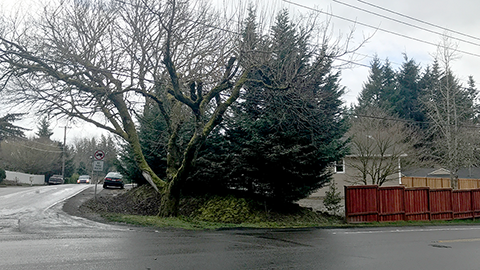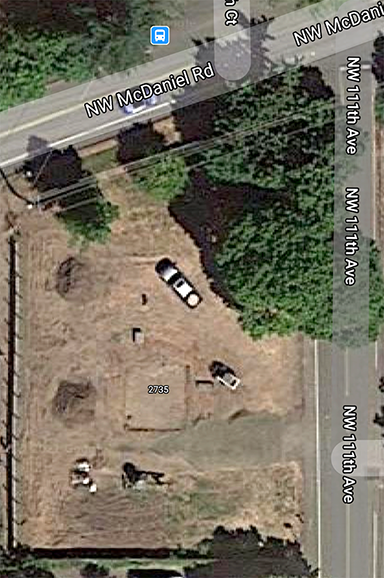County leaves ped-bike safety on the table

People who want safer routes for bicycles and pedestrians look to Washington County to, if not build them, at least encourage them. In some cases, a developer is required to build them when new houses go in.

In some cases, the county decides that public safety demands a capital project, paid for with our taxes. Much of the expense of such projects is the cost to purchase Right of Way (ROW) from the adjacent landowners.
But in some cases, Land Use and Transportation staff, with the advice of County Counsel, has determined that asking for even a dedication of land adjacent to roads for ROW would be asking too much.
Washington County handles development applications differently depending on several factors. A proposal to replace a single dwelling where a single dwelling has previously existed is considered a Type I application and entails a less-rigorous process and fewer requirements from the developer, including no requirement to dedicate ROW to current county standards. In most of the urban unincorporated area, that means no space for sidewalks, bike lanes, or even a wider road with curbs, because until 1983 sidewalks were considered optional.
So if, at some future time, the county decides that these amenities are a good idea, they have to purchase the ROW from the owner. In addition, because the ROW wasn’t required, there may not even be enough space to fit a wider road or sidewalks without encroaching on the house.
We have the perfect example of this with a new home just being completed at the corner of McDaniel Road and 113th. We’re not blaming the developer! He explained to me that he would have had to put three houses on the lot if he had been required to dedicate ROW. But since the county only required standard setbacks from McDaniel and 111th, there’s likely not enough land between the house and the roadway to even put a sidewalk on the McDaniel side. A sidewalk on the 111th side would take out most of the front yard.

This location, not far from Bonny Slope Elementary and close to a TriMet Line 50 bus stop, could surely use sidewalks. In 2013, the county built a “widened shoulder” on the west side of 111th. Although the county and other road authorities claim that it’s safer than walking in the roadway, many people disagree. In addition, if a bicycle and a pedestrian were both trying to travel there, someone would have to be in the road. A real sidewalk with a curb would be much safer.
Proportionality and nexus are key concepts in the US Constitution Fifth Amendment issue around “takings.” Nexus refers to actual physical proximity of the subject property to the proposed request. Proportionality asks whether the jurisdiction’s request is too much to ask considering the impact on the public.
From the county’s 2016 Long Range Planning Issue Paper on Solutions for Addressing Walkway Gaps in the Urban Unincorporated Area: “Current Planning staff has developed an administrative interpretation to exempt sidewalk requirements for single family detached homes on lots of record. This is based on the premise that the home to be constructed on the lot of record would not generate trips over and above what was already permitted on the site, and therefore public improvements would not be proportional to the development.” Whether or not additional trips are generated, the Issue Paper fails to acknowledge that in the years since the house was originally approved, county standards have changed and now require additional ROW to accommodate sidewalks and bike lanes.
In 2016 we wrote about “Nollan-Dolan,” a pair of cases that went to the Supreme Court and set the tone for the county’s stance. The article was in reference to the Shell station on Cornell, and why the county allowed it to trump the Town Center plan and normal sidewalk requirements.
However other jurisdictions have since won “takings” cases because there was a clear law on the books rather than an administrative decision. In West Hollywood, the city had a clear policy that all new multi-family housing developments needed to have affordable units, or pay into a fund. A developer of an 11-unit condo building took his case to the California Supreme Court, which upheld the city’s position. The US Supreme Court declined to take the case, thus upholding the California decision.
We feel that Washington County should enact an Ordinance requiring that ROW to current county standards be dedicated to the county on any property being redeveloped to ensure that adequate setback space would be left, so that if and when it becomes feasible to build bike-ped facilities, it would be physically possible and it would spare the taxpayers the expense of buying the land. In the meantime, the property could continue to be used by the owner. Fences, bushes, yards could be kept as is until the sidewalk or bike lane could be built.
Some are advocating for further solutions to sidewalk gaps, but we think this is a necessary first step. The Code & Ordinance Subcommittee of the Committee for Community Involvement (CCI) has been looking at this issue for some time. A new CCI subcommittee on Sidewalks and ROW is being considered. Comments are welcome, please send us an email to info@cedarmillnews.com.





